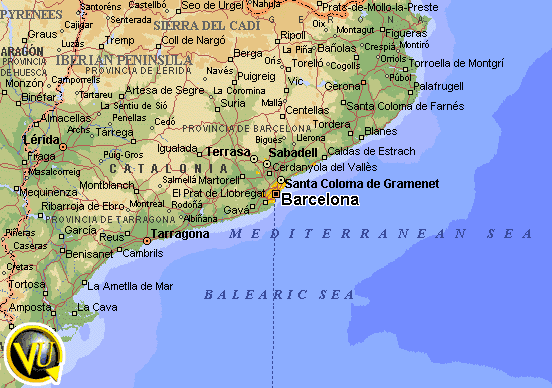
HOME Information Request Form Registration Form Conditions
| Spanish French German Italian Russian Chinese Japanese Greek Portuguese Summer Camps |
||
|
|
SPAIN : Barcelona
The school is a very modern 6-storeyed building. All the classes are air conditioned and are quite equipped with TV, video. The school also has a big conference and projection room, a multimedia centre with computers, CD rom, Internet, satellite television. Its terrace will give you an open view onto Barcelona Tuition Programs
Group activities |
Starting Dates Every Monday. Beginners must begin at the dates below.
D.E.L.E. preparation Spanish for business Closing Dates
Options Available
|
||||||||||||||||||||||||||||||||||||||||||||||||||
|
Costs Payable in Canadian dollars. Currency Converter The displayed prices are in Euros ( )
|
|||||||||||||||||||||||||||||||||||||||||||||||||||
|
|
|||||||||||||||||||||||||||||||||||||||||||||||||||
|
Accommodation: family, students residence, University residence (summer only), shared apartment, hotel 2*
Fees per week in Euros:
We should specify that the families will only speak with you the language of the country where you will be. It is the principle of the immersion courses! |
|||||||||||||||||||||||||||||||||||||||||||||||||||
|
Town's information
Catalonia, which currently has some six million inhabitants, was born as a carolingien market, in the IX century, when the area already had behind it a long prehistoric past, Iberian tribes, Phoenician and Greek colonies, of Roman domination, invasions of wisigothes then mahométanes, the latter being that which obliged the Francs to establish a defensive frontier zone. Thus was born slowly on the two sides of the Eastern part of the Pyrenees, a new country consisting of counties which, with time and thanks to Barcelona, was initially independent then, joined Aragon, became a kingdom whose Barcelona was the capital. At the end of the XV century, Catalonia and Aragon were linked with the kingdom of Castille and at the beginning of the XVII century, after the war of succession, Philippe V of Bourbon deprived Catalonia of its secular autonomy by establishing a centralized system. It is the moment where Barcelona became the most modern city of the country, thanks to its commercial and manufacturing effort. Its passed independence and its modernism consequently defined the ambiguous character of this Mediterranean city. Barcelona preserves monuments and ruins of all its historical periods, which makes it a very old city, filled with various memories
At the same time, various " shows " of fashion, as well as tastings of cooked dishes and wines take place. In October, the used Book Fair on Paseo de Gràcia, the Festival of Music; Fall Display, on Tinell, and several other " shows ". In November, All Saints' day and the Day of Deaths, the 1 and 2, when one eats the cakes called " panellets ". In Sainte-Lucie, December 13, begins the fair of the cribs, around the cathedral, of great typism, which lasts until Christmas. It is also the season of the Opera in Liceu, and the concerts in Palau of Música, which lasts several months. The festival of Christmas joins the family together around the traditional Crib, with the new found habit, of " hacer cagar Al tió " (trunk put in fire from which come out the gifts), and great meal with the "escudella " and turkey, (" neules "). The arrival of New Year's day is celebrated in the bars, the restaurants, the discotheques and the street, with people who disguise themselves. The principal festival of January is Kings Mages, the 5, day when ravels the cavalcade and the 6, with the toys and the gifts, for young and old. The Carnival, in February, is starting to recover its pulse, after its prohibition by the pro-Franco dictatorship. Saint Valentine , or celebration of loved ones, takes place the 14, gained also ground. In Gràcia, one celebrates, March 3, the popular festival of Sant Medir, with his cavalcade and his chorales. The Holy Week starts with the fair of the palms, where one carries Palm Sunday; it continues with the religious festivals of the week, and ends with, Easter Monday. On April 23, takes place the most splendid festival, of San Jorge, Patron of Catalonia, which coincide with the festival of the pinks and that of the books. In May, we have the poetic festival of the Floral Plays and, the 11 of the same month, the typical festival of Sant Ponç, of the herbalists, in the street of Hópital. In June, there is the fair of the Book, in Paseo de Gràcia; the Fair-Exposure to Monjuic;
|
|||||||||||||||||||||||||||||||||||||||||||||||||||
